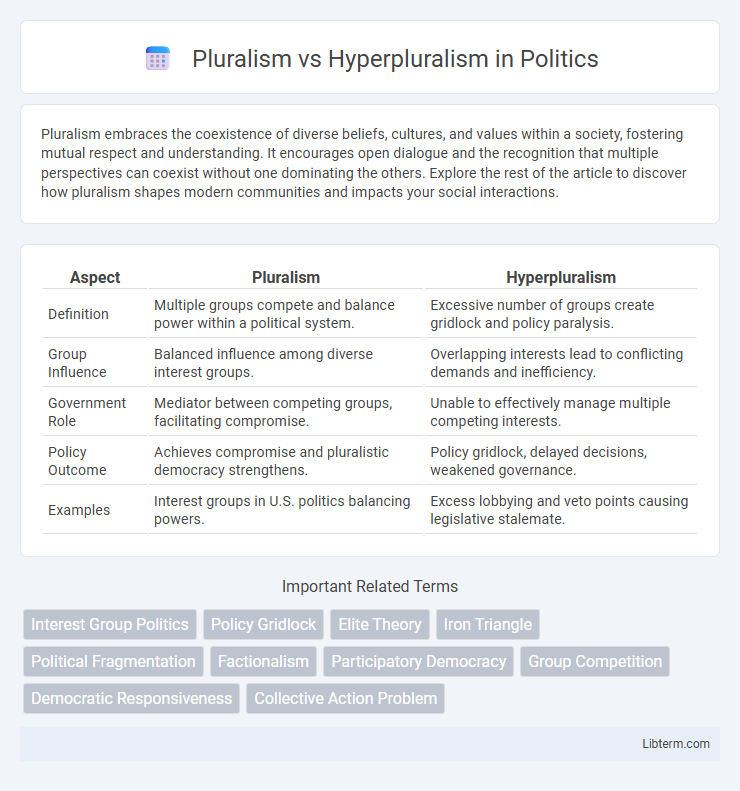Pluralism embraces the coexistence of diverse beliefs, cultures, and values within a society, fostering mutual respect and understanding. It encourages open dialogue and the recognition that multiple perspectives can coexist without one dominating the others. Explore the rest of the article to discover how pluralism shapes modern communities and impacts your social interactions.
Table of Comparison
| Aspect | Pluralism | Hyperpluralism |
|---|---|---|
| Definition | Multiple groups compete and balance power within a political system. | Excessive number of groups create gridlock and policy paralysis. |
| Group Influence | Balanced influence among diverse interest groups. | Overlapping interests lead to conflicting demands and inefficiency. |
| Government Role | Mediator between competing groups, facilitating compromise. | Unable to effectively manage multiple competing interests. |
| Policy Outcome | Achieves compromise and pluralistic democracy strengthens. | Policy gridlock, delayed decisions, weakened governance. |
| Examples | Interest groups in U.S. politics balancing powers. | Excess lobbying and veto points causing legislative stalemate. |
Understanding Pluralism: Core Concepts
Pluralism emphasizes a diverse range of organized groups competing and cooperating within the political system to influence policy outcomes, reflecting a balance of interests in democratic governance. Core concepts include the dispersion of power, the role of interest groups in representing varied societal demands, and the idea that no single group dominates decision-making processes. Understanding pluralism involves recognizing the dynamic interaction between competing factions that fosters compromise and prevents authoritarian control.
Defining Hyperpluralism: An Overview
Hyperpluralism describes a political system where numerous interest groups exert excessive influence, leading to policy gridlock and weakened government effectiveness. Unlike pluralism, which promotes balanced competition among diverse groups, hyperpluralism results in conflicting demands that overwhelm decision-making processes. This condition often causes fragmented policies and hampers the government's ability to address pressing issues efficiently.
Key Differences Between Pluralism and Hyperpluralism
Pluralism emphasizes the distribution of power among multiple interest groups that compete and cooperate to influence public policy, fostering balance and preventing dominance by any single group. Hyperpluralism occurs when too many groups become involved, leading to fragmented government policies, increased complexity, and policy gridlock, which hinders effective decision-making. The key difference lies in pluralism promoting a dynamic but functional competition of interests, while hyperpluralism results in excessive factionalism that weakens governmental authority and policy coherence.
Historical Development of Pluralist Theory
Pluralist theory emerged in the mid-20th century as a response to elite and Marxist models, emphasizing competition among diverse interest groups in democratic governance. Scholars like Robert Dahl highlighted how multiple groups influence policy without any single entity dominating, reflecting the decentralized power structure in the United States. Over time, critiques of pluralism led to the concept of hyperpluralism, arguing that excessive group competition results in policy gridlock and government inefficiency.
Rise of Hyperpluralism in Modern Societies
The rise of hyperpluralism in modern societies reflects an increasing number of interest groups that compete to influence public policy, often leading to governmental gridlock and inefficiency. Unlike traditional pluralism, where diverse groups coexist and balance power, hyperpluralism results in fragmented policymaking due to excessive demands from conflicting factions. This phenomenon is evident in complex democracies like the United States, where the proliferation of lobbyists, advocacy organizations, and political action committees complicates consensus-building and effective governance.
Impacts of Pluralism on Democratic Governance
Pluralism fosters a competitive political environment where multiple interest groups influence policy-making, promoting governmental accountability and responsiveness to diverse public needs. This diversity of voices leads to more balanced policy decisions, as no single group dominates the political agenda, thereby enhancing democratic legitimacy. However, pluralism can also slow decision-making processes, as negotiating among competing interests requires compromise and deliberation.
Challenges Posed by Hyperpluralism
Hyperpluralism presents challenges such as gridlock in government decision-making due to excessive competing interest groups, making it difficult to achieve consensus or effective policy implementation. The proliferation of specialized factions dilutes political power and fosters conflicting demands that overwhelm legislative bodies. This results in fragmented governance and decreased accountability, complicating the passage of coherent laws or reforms.
Case Studies: Pluralism vs Hyperpluralism in Practice
Case studies in political science reveal pluralism as a system where diverse groups coexist and influence policymaking through negotiation and compromise, exemplified by the American lobby system that balances interests across multiple sectors. Hyperpluralism, contrastingly, occurs when an excess of competing groups causes policy gridlock and inefficiency, as seen in the U.S. Congress debates on healthcare reform where numerous interest groups produced conflicting demands hindering legislative progress. These cases highlight how pluralism supports democratic coordination, while hyperpluralism undermines effective governance due to oversaturation of competing interests.
Evaluating the Effectiveness of Both Models
Pluralism promotes a balanced distribution of power among diverse interest groups, fostering negotiation and compromise that can lead to effective policy-making. Hyperpluralism, characterized by an overwhelming number of competing groups, often results in policy gridlock and inefficiency due to conflicting demands and excessive influence on government institutions. Evaluations indicate that while pluralism supports democratic responsiveness, hyperpluralism can hinder governance by fragmenting authority and causing legislative stalemates.
Future Perspectives: Balancing Diversity and Governance
Future perspectives on pluralism emphasize fostering inclusive decision-making processes that accommodate diverse interests without overwhelming institutional capacity. Managing hyperpluralism requires innovative governance frameworks that enhance coordination among multiple stakeholders while preventing policy fragmentation. Embracing adaptive policies and technological integration can balance diversity with effective governance, ensuring democratic stability and responsiveness.
Pluralism Infographic

 libterm.com
libterm.com